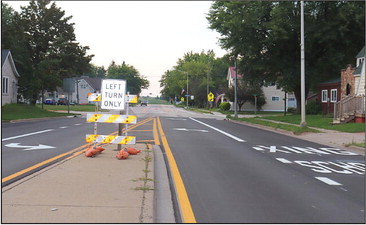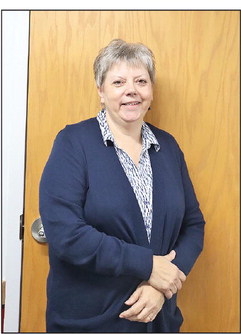Baird study provides general insights on fiscal impact of Loyal, Greenwood consolidation
By Cheyenne Thomas In March, members the Greenwood and Loyal school boards decided to pay $6,000 per school district for Robert W. Baird and Company to conduct a consolidation financial feasibility study with the hopes of gaining an understanding of how combining the two school districts would impact the schools’ mill rate and overall financial situation. In a recent meeting, the boards received the longawaited results of the study, but found the results to be focused on a general financial picture of the two districts and not provide a clear path forward.
In a joint meeting of the Loyal and Greenwood school boards on Oct. 4, the boards and 13 community members listened to the fiscal consolidation analysis presented by Elise Murn, a business specialist from Baird. During the hour-long presentation, Murn presented information about what district finances would look like if the Loyal and Greenwood school districts were to consolidate into one school district. Both boards are expected to have follow-up discussions on the presentation at their regular November board meetings.
In the presentation, focus was put on the potential school levy, mill rate and budget impact of a consolidated school district and what that would look like in the first five years.
“This does not analyze facility needs, staffing or curriculum and is not a stepby- step presentation on a consolidation process,” explained Murn. “We’re not able to give advice on whether or not the districts should consolidate or not. This is just a look at the finances of a hypothetical consolidated school district. There are a lot of unknowns.”
The first thing Murn touched on in her presentation was that the timeline for consolidation has three different paths with their own timeframe. The process can take as short of time as 12 months to complete, to 14 months or up to 18 months. In order for the process to begin, the two boards would have to authorize a resolution to consider consolidation. After that date of resolution, The two boards would have to be restructured into an interim joint school board that would continue to operate during the consolidation process.
After explaining the timeline of a consolidation scenario, Murn explained the two biggest factors that would initially impact a consolidated Loyal-Greenwood school district. The first would be equalization aid. While all school districts receive equalization aid from the state, when a school district is consolidated, Murn said, for the first five years of the consolidated district’s existence, their aid is added together and set at a fixed rate, based on each district’s individual aid when they were last separate. After the five years are up, they are treated just like any other school district and will receive equalization aid as if they were a nonconsolidated district.
“After the first five year period that would change,” she told the board. “They would be treated just like any other school district and how it’s funded.”
The second impact caused by consolidation is a small amount of additional funding called consolidation incentive aid. Amounting to $150 per student, Murn said the consolidated district would see a very modest boost in funding as a result of consolidating.
“It’s kind of a misnomer,” she said. “It’s not very incentive. At just $150 per student it’s not enough of a financial boost that would give any school district incentive to combine. It has a less than one percent impact on the budget and it’s best used towards one-time budget items.”
After the school districts are consolidated, Murn said additional financial impacts would be seen. Since both districts have their own operational referendums in place, those would be voided if the districts were to combine before the referendums end in 2028. There would also be a decrease in the amount of students open enrolling out, increasing student aid.
“If they’re consolidated, there will be no more open enrollment to the other district,” said Murn. “They would all be resident students, which has a different amount of student aid they receive per student. It’s $11,325 that the district receives for a resident student and $8,962 for an open enroll student. It’s a small benefit.”
When comparing class size and student enrollment, Murn said both Greenwood and Loyal have similar numbers, which means neither district is losing benefits to the amount of student aid they receive by consolidating.
Please see Baird study, page 6 Baird study,
from p. 1
"In this case, it's just like adding the two schools together," she said. "In other schools, it can be obvious if the districts will be better or worse off. That's not the case here." This "adding the two schools together" is something Murn said she also saw when looking at the amount of debt that both districts have. Once again, she said both schools are similar, with no large amounts of outstanding debt.
"Neither district is coming into this with referendum approved debt or any other kind of debt," she said. "Which is not what you see a lot of time with a consolidation. Oftentimes, there is one district with a lot of debt that the other district is taking on. Instead, about half of the school levy is from operational referendums." After the two districts are combined, Murn said the school's financial future changes within the first four years. Without an operational referendum, by year four into the consolidated district, the district falls into an approximate $3 million deficit. In order to prevent that, an operational referendum would have to be passed for the new combined district.
"Both districts operate with operational referendums right now that help them stay afloat," she said. "But those referendums would be nullified when they consolidate. What you are looking at is what the financial future looks like without those referendums in place. You would be in the hole without an operational referendum, just like it is right now." After the presentation, a few questions were asked by board members about the results of the survey and if Baird is able to complete a consolidation study that examines more than the financial impact of consolidation. Murn said that Baird does not provide services like that, and that if the districts were interested in taking further steps towards consolidation, they would have to reach out to the Department of Public Instruction for a proper consolidation study. Both the Greenwood and Loyal boards are to hold discussion about the results of the study at their monthly November meetings. The Loyal Board of Education will meet on Nov. 20 at 7 p.m. and the Greenwood School Board will meet the following day, Nov. 21, at 7 p.m.




